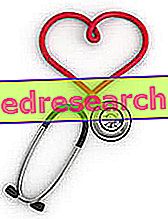Generality
Myoglobin is an oxygen transport protein that can be measured by simply drawing blood from a vein in the arm.
Together with troponin, myoglobin is one of the most used markers to confirm or rule out any cardiac damage .
What's this

Its color is red, a tone given by the presence of an EME group.
Note: hemoglobin transports oxygen to most of the body, while myoglobin traps oxygen in the muscles to allow cells to work properly. When the heart or another skeletal muscle is damaged, myoglobin is released into the blood.
In the case of cardiac damage, ischemic tissue - being in a state of oxygen shortage - releases abnormal amounts of myoglobin to counteract the insufficiency of this element.
Biological role
Myoglobin is a protein concentrated in the muscle, where it facilitates the extraction of oxygen from the blood capillaries.
Once oxygen is bonded, myoglobin transports it into the cell, more precisely into the mitochondria, where it is used for energy production.
Myoglobin and heart attack
When performing blood tests, myoglobin is sought as a marker of heart damage ; this protein is in fact released very quickly from the ischemic myocardial tissue, suffering from the reduced influx of oxygen. With the same speed with which it appears in the plasma, myoglobin tends, however, to go away, disappearing within a few hours thanks to the excretion work done by the kidneys.
Numbers in hand, plasmatic myoglobin tends to rise within 2-3 hours of cardiac infarction, or other muscle damage, reaching a peak after about ten hours and falling to basal levels within 24 hours.
Therefore, if a patient complains of symptoms of a heart attack (chest pain, anxiety, air hunger, nausea, sweating), and his plasma myoglobin levels do not rise significantly within ten hours, it is very unlikely that the origin of the symptoms are linked to heart damage.
For what said, if the first symptoms appeared more than 24 hours before the test, the finding of normal levels of myoglobin in the blood does not guarantee the absence of ischemic lesions, since the marker could have already been completely filtered and eliminated by the kidneys .
From a clinical point of view, therefore, the trend of serum hemoglobin levels over time is also important; an early elevation followed by a rapid decrease may in fact indicate that the cardiac lesion is circumscribed and not expansive; conversely, maintaining high myoglobin values over time may indicate that the lesion is expanding.

To obtain greater diagnostic indications, the dosage of myoglobin is carried out together with that of other markers of cardiac damage, such as troponin and CK-MB; unlike myoglobin, these two substances are considered specific markers of cardiac damage. The increase in myoglobin, on the other hand, is a sign of a generic muscle damage, which can be localized to the heart but also to the muscles.
The advantage of measuring myoglobin together with troponin and CK-MB, or other markers of cardiac damage, lies precisely in the rapidity with which its levels are raised in the blood.
Why do you measure
Myoglobin is a marker that helps determine if the muscle, particularly the heart muscle, has been damaged.
The examination is indicated by the doctors of the Emergency Department every 2-3 hours after the onset of the typical symptoms of a heart attack, such as chest pain and difficulty breathing; usually the dosage of myoglobin is performed together with that of troponin, to better exclude a heart attack.
The times for evaluating myoglobin as an indicator of cardiac damage are relatively tight: this protein is one of the first markers that increases at the blood level after the pathological event, but tends to reduce within a few hours, due to excretion through the kidneys.
Normal values
- Normal levels of myoglobin in the blood: 0 - 85 ng / mL
Reference values may vary slightly from laboratory to laboratory.
High Myoglobin - Causes

High myoglobin - Extracardiac causes
Serum myoglobin levels may also increase due to injuries (rhabdomyolysis) and muscle diseases, for example due to trauma, accidents, surgery, intramuscular injections, strenuous muscle exercise, muscular dystrophy or myositis.
An important muscle trauma, with large quantities of myoglobin circulating, can cause acute renal failure, since at high concentrations this protein becomes toxic to the tubular epithelium of the kidney. At the same time, severe renal dysfunction generally accompanies high levels of circulating myoglobin.
Rarely, severe alcohol abuse and some medications can cause muscle damage and increase myoglobin.
Possible causes of High Myoglobin |
|
Low Myoglobin - Causes
Low levels are not usually associated with medical problems and / or pathological consequences.
How to measure it
Myoglobin dosage is performed on a blood sample taken from a vein in the arm.
Preparation
Generally, no preparation by the patient is required for the myoglobin examination.
Interpretation of Results
High myoglobin values indicate an ongoing cardiac distress . The levels of this protein begin to increase within 2-3 hours of heart attack or other muscle damage, reaching high levels in the next 8-12 hours; generally, myoglobin values return to normal the day after the pathological event. As a result, the exam is used to help rule out a heart attack in the emergency room .
High levels of myoglobin must be compared with the results of other tests, such as creatine kinase (CK-MB) or troponin; this makes it possible to establish whether the damage is actually on the heart or involves another skeletal muscle.
An increase in myoglobin values can be seen in the event of accidents, strokes, surgery or myopathies, such as muscular dystrophy.



